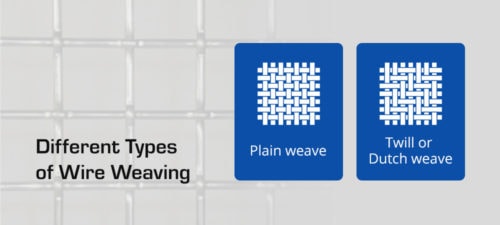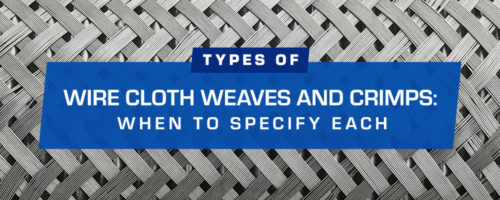Types of Wire Cloth Weaves and Crimps: When to Specify Each
Leave a CommentTypes of Wire Cloth Weaves and Crimps: When to Specify Each
You can use wire cloth in many industries, from aerospace engineering to radio and microwave production. Also called wire mesh or wire fabric, this solution can filter materials, shield employees from hazards, insulate and much more.
Wire cloth is available in different styles, each with its own advantages. Here is a basic overview of wire cloth types.
Differences Between Welded and Woven Wire Cloth
There are two major types of wire cloth — woven and welded. Each product type is produced differently, presenting different benefits depending on the reason for the material. You can use both in a variety of applications and industries.
Welded Wire Cloth
Welded wire mesh is a highly durable material, often used for fencing or caging purposes. During construction, welded wire cloth is permanently welded at all intersections. This method makes the cloth rigid, holding a consistent shape during use. For industrial applications, welded wire maintains its shape, allowing it to fit precisely into structures and components without difficulties.
Here are the key features of welded wire cloth:
- Applications: Many industries use welded wire cloth. Its high strength makes it a popular option for fencing and other barriers. Welded wire cloth is commonly used in industrial, agricultural and transportation fields, and it may also be used for air reduction in vents. Welded mesh is available in many different materials, including stainless steel and carbon steel. It can be made with heavy-gauge wire to a 0.025-inch-diameter wire, making it versatile for different uses.
- Advantages: Due to the nature of its shape, welded wire mesh can achieve higher strengths using thinner wires. The cloth also has a higher percentage of open area.
- Disadvantages: Welded wire cloth with particularly large openings might need to be custom manufactured, but most sizes are still available off the shelf. Similarly, due to the nature of production welded wire cloth cannot be made in fine mesh counts.
Woven Wire Cloth
This material consists of a series of metal wires interlaced to make a sheet of wire cloth. Instead of being welded together like welded mesh, woven wire is interlaced together. Wires can be woven together into particular diameters or patterns. The woven nature allows for more flexibility.
Features of woven wire cloth to know include:
- Applications: You can make woven wire cloth out of steel, stainless steel, aluminum, brass, copper alloys and more. You can shape these materials in a variety of ways. Woven wire cloth is utilized in air filtration, baskets, doors and many other industries.
- Advantages: In woven wire cloth, the openings can be much finer than in welded fabric. This makes it a great option for installations like filters or insect screens. Woven wire cloth is also extremely durable and can hold high weights.
- Disadvantages: Some types of woven wire mesh could become unraveled on the ends, but you can avoid this with wire weaving techniques that offer high rigidity.
Different Types of Wire Weaving
If you select woven wire fabric, many types of weaves are available. Each style varies by mesh count, wire diameter specifications and the number of openings.
Here are two of the most common types of wire mesh patterns:
- Plain weave: The plain weave is the most common type. It consists of same-sized diameter wires in a simple over-and-under pattern. The identical design creates the same amount of mesh openings in all directions.
- Twill or Dutch weave: A twill weave is slightly more complicated than a plain weave, with each wire passing over and under two wires. This structure makes the twill weave more durable and available for larger diameters.

Types of Woven Wire Crimp Styles
Woven wire often uses a method known as crimping either before or during creation. If the mesh’s diameter is too big or too small, specialists crimp the wires before weaving. They send the wires through a crimper, and it individually shapes them so they can rest securely against one another. Crimped wire mesh makes the wire fabric stronger and more rigid.
Here are a few of the crimp styles available for wires:
- Lock crimp: The lock crimp is a more modern style. It consists of straight sections of wires, where each wire is crimped at each intersection. Lock crimp wire mesh creates an aesthetically pleasing pattern and is also very stable.
- Double intermediate crimp: A double intermediate crimp forms a square-like pattern with wires of equal size. They pass over and under one another at adjacent intersections with equal lengths.
- Intercrimp: An intercrimp style uses intersecting wires at every other intersection. For example, wires might intersect at the third intersection, the fifth intersection and so on. This style provides high rigidity and is popular in architecture.
- Flat top: A flat top crimping style is similar to a lock crimp wire cloth, but all crimps are offset to one side. This design creates a flat appearance on the front, making it ideal for materials to flow smoothly across it. It’s also commonly used in architecture.
How to Match Weave and Crimp Style
By matching your crimp and mesh weaving style, you can create an optimized woven wire cloth. The right combination of weaving and crimping styles can make your wire mesh more sturdy or flexible. But with all the crimping options and wire cloth terms, it’s sometimes tricky to know which style fits you best.
Here are three considerations for picking your weave and crimp styles:
1. Wire Diameter
The wire diameter is the width of each wire. The diameter directly effects how much open space exists between wires.
You can choose diameter according to what conditions your wire will face. For instance, if your wire will mostly encounter small amounts of sand, you wouldn’t need an extremely thick diameter. Usually, the thicker and stronger your wire is, the more you avoid future fixes and replacements.
2. Mesh Count
Your wire’s mesh count is the number of openings within an inch. So, if you have a 300 mesh wire, there are 300 openings within one inch in any direction of the wire. When selecting mesh count, consider how many materials will pass through your wire and how many of those you want to block.
If you choose the wrong mesh count, unwanted materials or substances might reach underneath surfaces. Or, too many substances might build up on your mesh because they can’t pass through.
3. Micron Rating
A micron rating is a precise distance between your wires. Once you determine your diameter and mesh count, you can decide upon the best micron rating for your wire’s purposes. People often use micron ratings for wire mesh meant for filtration. The correct micron measurement allows for proper filtration while maintaining a consistent substance flow.
Order Woven Wire Cloth to Your Specifications
Whether you need wire mesh for filtering materials or handling sensitive liquids, Argus Steel is here for you. A leader in the metals industry, Argus Steel has provided premier materials since 1979. Our specialty wire cloths are available in many different materials and meet any requirement. We offer durable and high-quality wire cloth, no matter what use you have in mind.
Request a quote from Argus Steel today to get started with a leading steel wire distributor. No job is too big or too small for us, and we look forward to finding you the best wire cloth fit.



